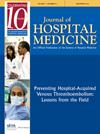临床进展:二级骨折预防。
IF 2.3
4区 医学
Q1 MEDICINE, GENERAL & INTERNAL
引用次数: 0
摘要
脆性骨折后的骨质疏松症未被充分诊断和治疗。医院医生应该能够对骨质疏松严重程度进行风险分层,以指导治疗决策。双膦酸盐仍然是治疗的基石。然而,骨折风险最高的患者在使用双膦酸盐前可能受益于合成代谢治疗。行为和环境预防跌倒措施对预防未来骨折也起着关键作用。医院医生在帮助解决骨质疏松症护理方面的差距方面处于有利地位,特别是对于已经骨折且风险最高的患者。本文章由计算机程序翻译,如有差异,请以英文原文为准。



Clinical progress note: Secondary fracture prevention
Osteoporosis is underdiagnosed and undertreated after fragility fractures. Hospitalists should be able to risk stratify osteoporosis severity to guide treatment decisions. Bisphosphonates remain the cornerstone of treatment. However, patients with the highest fracture risk may benefit from anabolic therapy before bisphosphonate use. Behavioral and environmental fall prevention measures also play a key role to prevent future fractures. Hospitalists are well-positioned to help address the gap in osteoporosis care—especially for patients who have already fractured and are at highest risk.
求助全文
通过发布文献求助,成功后即可免费获取论文全文。
去求助
来源期刊

Journal of hospital medicine
医学-医学:内科
CiteScore
4.40
自引率
11.50%
发文量
233
审稿时长
4-8 weeks
期刊介绍:
JHM is a peer-reviewed publication of the Society of Hospital Medicine and is published 12 times per year. JHM publishes manuscripts that address the care of hospitalized adults or children.
Broad areas of interest include (1) Treatments for common inpatient conditions; (2) Approaches to improving perioperative care; (3) Improving care for hospitalized patients with geriatric or pediatric vulnerabilities (such as mobility problems, or those with complex longitudinal care); (4) Evaluation of innovative healthcare delivery or educational models; (5) Approaches to improving the quality, safety, and value of healthcare across the acute- and postacute-continuum of care; and (6) Evaluation of policy and payment changes that affect hospital and postacute care.
 求助内容:
求助内容: 应助结果提醒方式:
应助结果提醒方式:


